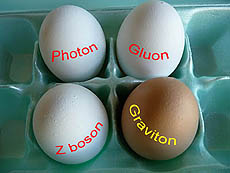Gravitons
 |
| Sesame Street has a learning game that goes with the jingle "One of these things is not like the other. One of these things just doesn't belong." Can you find which one is different? |
Read the expanded column on gravitons.
If you've read anything about the kinds of physics we do at Fermilab, you've heard lots of words ending with "on" – words like proton, neutron, gluon, photon, boson, fermion and on and on and on. One of the words you might have encountered is the graviton. Let's get one thing out of the way: At the moment, gravitons are entirely theoretical constructs that delicately walk the knife-edge precipice between the domains of scientific respectability and the shady world of hand waving.
The fantastic success of quantum theory to describe three forces – electromagnetism and the strong and weak nuclear forces – provides a considerable impetus to try to marry it to the fourth force of gravity. In the same way that the photon is known to be the quantum particle of the electromagnetic force and the gluon is the quantum particle of the strong force, the "graviton" is the name given to a hypothetical quantum particle of the gravitational force.
However, a quantum theory of gravity has so far been elusive. Einstein's theory of general relativity has been the most successful description of gravity, but when it encounters the quantum realm, it predicts nonsense, with impossible infinities popping up throughout the calculations. Infinities like that are nature's way of saying "back to the drawing board." And though theoretical physicists have quite a way to go in coming up with such a model, it is still possible to work out some of the properties of gravitons.
For instance, we know that gravity has infinite range and can bind together distant galaxies. This means that the traditional graviton has zero mass. Further, empty space has no electrical charge in it, which means the graviton, which would operate through empty space, must be electrically neutral.
More sophisticated thinking tells us what the quantum mechanical spin of the graviton must be. While the matter particles of the Standard Model are spin 1/2 and the Standard Model force carrying particles have a spin of 1, gravitons must have a spin of 2.
It turns out that this spin thing is a big deal, as you can prove that any massless spin-2 particle must act exactly as a graviton is predicted to behave. Thus if we find a massless spin-2 particle, we'll know it's a graviton. This spin-2 behavior also explains the fact that conventional gravity only attracts, unlike electromagnetism, which both attracts and repels.
Gravitons are a theoretically reputable idea but are not proven. So if you hear someone say that "gravitons are particles that generate the gravitational force," keep in mind that this is a reasonable statement, but by no means is it universally accepted. It will be a long time before gravitons are considered part of the established subatomic pantheon.
—Don Lincoln
Want a phrase defined? Have a question? E-mail today@fnal.gov.
|